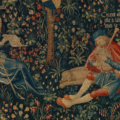O Cebreiro is a small mountain community in Lugo, Spain –so small that only a few hundred people live there. And yet, small as it is, it was once the heart (literally) of a kind of religious renewal: the place became famous for a legendary, miraculous event. It all began on a stormy, unpleasant winter night in the early 14th century.
That night, a friar celebrated mass alone. No one could attend. Who would even think of crossing the thick snow and braving the wind? Well, lo and behold. The church door opened and a villager, Juan Sentin, walked in –certainly not in his Sunday best, having braved the storm.
The friar spoke a few words of contempt for the devoted Juan, thinking it imprudent to risk his life just to see “a piece of bread and some wine.” Legend has it that when the priest consecrated the species (that is, the bread and wine of the Mass), real blood and flesh miraculously appeared on the altar.
We know this story thanks to the Carmelite Fr: Antonio de Yepes, who wrote about it in his General Chronicle of the Order of St. Benedict in the 16th century. But the legend is much older than the friar’s text –and it certainly spread like wildfire among pilgrims on their way to Santiago during the Renaissance. O Cebreiro has been an important landmark for those arriving on the French Route almost since the earliest days of the Camino: a hospital for pilgrims has stood there since the early 9th century.
In 1486, the Catholic Kings stopped at O Cebreiro during their pilgrimage to Santiago de Compostela, granting gifts and privileges to the place. Legend has it that Queen Isabel wanted to take the miraculous chalice and paten with her, but the horses in her carriage refused to leave until she took the liturgical vases back to the church.
O Cebreiro fell into oblivion for centuries, as the political and social unrest caused by the Reformation led to a decline in pilgrimages to Compostela until 1957, when a new parish priest, the renowned Elías Valiña, arrived in the village. Well aware of the importance of O Cebreiro (and of the Camino de Santiago itself), he decided to dedicate his life to the promotion and preservation of this pilgrimage route.
But is this the Grail?
According to tradition, the Holy Grail is the cup that Jesus used during the Last Supper. Legend has it that it was zealously preserved and saved from the destruction of Jerusalem in 70 A.D. The name is first found in the works of Chrétien de Troyes –the famous French minstrel who collected the medieval tales woven around the legendary relic.
As is often the case, several “Grails” claim to be the authentic one – although the Holy Chalice guarded in the Spanish city of Valencia, which even has its own pilgrimage route, is considered the authentic one.
Curiously, although the name is misleading, the Grail of O Cebreiro was never intended to be the Holy Grail. The chalice and paten kept in Galicia have been dated to the twelfth century –their manufacture being clearly, undisputably medieval.
The American medievalist Matthew Kuefler explains, in How the Holy Grail ended up in O Cebreiro, that this is just a linguistic confusion built around the name of Saint Guiral (also known as Saint Gerald of Aurillac), the patron saint of the pilgrims’ hospital that Alfonso VI of León entrusted to the Benedictine monks.
Nevertheless, it is clear that legends about the search for the Holy Grail found fertile ground among medieval European pilgrims. The Arthurian cycle, begun by Chrétien de Troyes and continued by the troubadours Robert de Boron and Wolfram von Eschenbach, quickly spread throughout Christendom –including the Camino.





